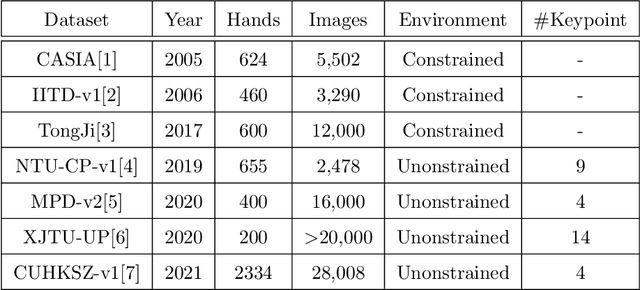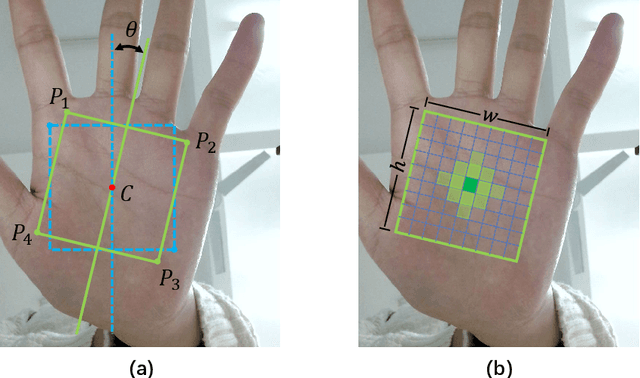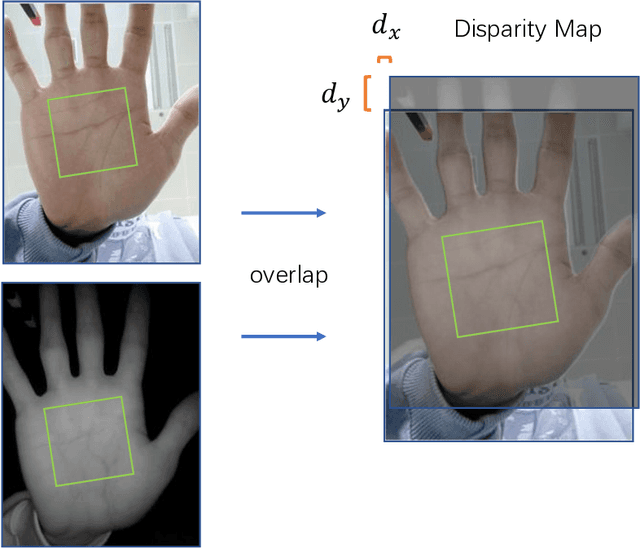Dandan Fan
BPFNet: A Unified Framework for Bimodal Palmprint Alignment and Fusion
Oct 04, 2021



Abstract:Bimodal palmprint recognition leverages palmprint and palm vein images simultaneously,which achieves high accuracy by multi-model information fusion and has strong anti-falsification property. In the recognition pipeline, the detection of palm and the alignment of region-of-interest (ROI) are two crucial steps for accurate matching. Most existing methods localize palm ROI by keypoint detection algorithms, however the intrinsic difficulties of keypoint detection tasks make the results unsatisfactory. Besides, the ROI alignment and fusion algorithms at image-level are not fully investigaged.To bridge the gap, in this paper, we propose Bimodal Palmprint Fusion Network (BPFNet) which focuses on ROI localization, alignment and bimodal image fusion.BPFNet is an end-to-end framework containing two subnets: The detection network directly regresses the palmprint ROIs based on bounding box prediction and conducts alignment by translation estimation.In the downstream,the bimodal fusion network implements bimodal ROI image fusion leveraging a novel proposed cross-modal selection scheme. To show the effectiveness of BPFNet,we carry out experiments on the large-scale touchless palmprint datasets CUHKSZ-v1 and TongJi and the proposed method achieves state-of-the-art performances.
Touchless Palmprint Recognition based on 3D Gabor Template and Block Feature Refinement
Mar 03, 2021



Abstract:With the growing demand for hand hygiene and convenience of use, palmprint recognition with touchless manner made a great development recently, providing an effective solution for person identification. Despite many efforts that have been devoted to this area, it is still uncertain about the discriminative ability of the contactless palmprint, especially for large-scale datasets. To tackle the problem, in this paper, we build a large-scale touchless palmprint dataset containing 2334 palms from 1167 individuals. To our best knowledge, it is the largest contactless palmprint image benchmark ever collected with regard to the number of individuals and palms. Besides, we propose a novel deep learning framework for touchless palmprint recognition named 3DCPN (3D Convolution Palmprint recognition Network) which leverages 3D convolution to dynamically integrate multiple Gabor features. In 3DCPN, a novel variant of Gabor filter is embedded into the first layer for enhancement of curve feature extraction. With a well-designed ensemble scheme,low-level 3D features are then convolved to extract high-level features. Finally on the top, we set a region-based loss function to strengthen the discriminative ability of both global and local descriptors. To demonstrate the superiority of our method, extensive experiments are conducted on our dataset and other popular databases TongJi and IITD, where the results show the proposed 3DCPN achieves state-of-the-art or comparable performances.
 Add to Chrome
Add to Chrome Add to Firefox
Add to Firefox Add to Edge
Add to Edge